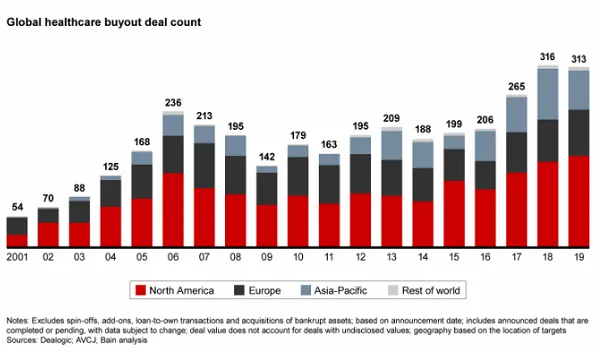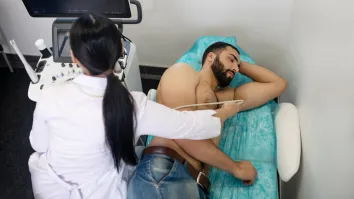
APAC healthcare deal value dropped 29% to $11.5b in 2019
The total deal size in Southeast Asia surged to $2.4b.
The total disclosed healthcare deal value in the Asia Pacific crashed by 29.01% from $16.2b in 2018 to $11.5b in 2019, according to a Bain & Company report. Despite the decline, the figure records the second highest amount since the 2008 financial crisis.
“Compared with prior years, deal activity was dispersed more widely across the region. China faced geopolitical uncertainties and regulatory reform throughout the year, resulting in what should be a short-term dip in activity. Still, disclosed deal value was over 60% above its five-year average,” said Vikram Kapur, a partner at Bain & Company Singapore.
In 2019, the largest deal is Bermuda-bases private equity (PE) firm Brookfield Business Partners’ $4.1b acquisition of Australian hospital provider Healthscope.
In addition, the deal value in Southeast Asia surged from nearly $720m in 2018 to $2.4b in 2019, which is noted to have historically constituted a small share of the APAC region’s deal value.
Southeast Asia also saw the second-largest deal of the year, which is the $1.2b acquisition of the Southeast Asian assets of Malaysia-based Columbia Asia Hospitals by a consortium of TPG and Hong Leong Group.
“Investors continued to look across country borders to place capital, including assets that have a large exposure across the region, even if not headquartered in the region,” Kapur added.
Case in point the report cited Baring Private Equity Asia that made two notable investments with this profile. The fund acquired US-headquartered HCIT platform CitiusTech for over $1b. Baring Private Equity Asia also bought Lumenis, a medical equipment manufacturer that sells laser equipment for minimally invasive surgery from XIO Group, which is also valued above $1b.
Provider platforms lead
Healthcare provider platforms account for 43% of the 2019 deals as investors continue to focus on consolidating hospitals and labs to execute buy-and-build strategies and develop scaled platforms.
“The private sector has stepped in to build hospital platforms where people lack access to care. For example, KKR Asia and GIC Special Investments invested more than $684m in Metro Pacific Hospitals, the operator of the largest private hospital network in the Philippines. In laboratories, TPG added to its Pathology Asia Holdings platform by acquiring a minority stake in Australian drug testing company Safe Work Laboratories,” Kapur noted.
Another trend observed is the increasing focus on Chinese biopharma firms, where the deal size grew despite the unchanged number of investments (17) in 2019 compared to the previous year. This came after the introduction of the Chinese national government’s volume-based procurement pilot programme.
APAC’s largest deal of the year was Centurium Capital’s $1.9b take-private offer for the remainder of China Biologic Products Holdings, a plasma collection network and fractionator.
“The deal provides exposure to a profitable and rapidly growing industry in the plasma-derived therapy market. ” Kapur said. “Over the past several years, the Chinese government has been trying to increase the quality and affordability of healthcare. A pilot programme aims to migrate away from high-priced, off-patent branded drugs to generics through volume-based procurement. “
Furthermore, the programme could dramatically reduce the cost of drugs through bulk buying in hospital systems, which are the primary distribution channel. It is likely to result in a winner-take-all outcome, whilst prices will decline substantially and the winners will benefit from large volume increases.
“In the first wave, 11 cities implemented a bulk purchase of 25 drugs, reducing some prices by over 90%. The second wave of the volume-based procurement programme rolled out to the rest of China in the second half of 2019, leading to broader price cuts in off-patent drugs manufactured by foreign multinationals,” Kapur added
Chinese biopharma companies may likely be best positioned to win the major contracts, which should lead to expanded investment in the near future. Longer term, Chinese companies might compete on the global stage in a fashion similar to Indian generics.
Another trend Kapur observed is the sizeable gap in healthcare access persists across most of the region as physical infrastructure cannot be built quickly enough to meet the unmet healthcare needs.
“However, a propensity for digital adoption throughout Asian countries has allowed digital platforms to help address those needs, often with the participation of PE investors,” Kapur stated.
For example, CITIC Private Equity Funds Management, CICC Capital and Baring Private Equity Asia made a $1b investment in online pharma platform JD Health. PharmEasy, an Indian digital pharmacy platform, also received $220m in an investment round led by Temasek Holdings that included a number of other funds and investors.
Set for growth
APAC’s growing ageing population is poised to boost the demand for healthcare services as 60% of 460 million people over 65 years old in 2025 are in the region. Rising healthcare costs will also prompt firms to create more cost-effective delivery models to gain a stronger foothold.
Another cause for the increasing demand of healthcare solutions is the lack of physician resources. A Bain survey found that nearly half of physicians believe it will be more difficult to deliver high-quality care over the next five years due to lack of funding and resources, rising costs and a shift toward treating chronic patients.
A number of consumers are also said to be calling for shorter waiting periods and more affordable means.
Apart from these upcoming trends, regulators are becoming more keen on the overall healthcare sector in APAC addressing access, cost and quality constraints as evidenced by moves toward universal healthcare in China, Indonesia and recently in India and the Philippines.
“Many regulators recognise that digital solutions will be critical, which shapes policy reform and suggests a need for coordinating their programmes. Deal activity is likely to continue the trends of digital health, development of buy-and-build provider platforms benefiting from a fragmented and unorganized market, and a push into biopharma,” Kapur added.



















 Advertise
Advertise





